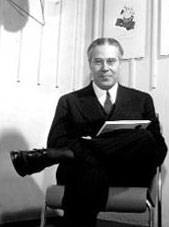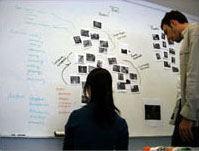
In today’s high-tech world, technology often seems to be driving us instead of the other way around. Overnight, products and services appear that just days before we were unaware of—for example, the ability to now use a cell phone to send a photograph of the house we’ve just built to a friend half way around the world.
Technology isn’t the only area where change is rampant. Lifestyles are constantly being reconfigured, with demographic patterns in such flux that it may be misleading to call them patterns. All these rapid changes are making it more and more difficult to predict how people as consumers want and need to be served.
Finding out is the goal at IIT’s Institute of Design (ID), where researchers develop methods that will help organizations gain a more detailed and relevant understanding of users’ increasingly complex lives and drive the development of innovative and humane products and business concepts. Put simply, ID faculty and students study exactly how people live and work and then strive to develop ideal products, systems, and concepts for them—a task that is every bit as challenging as it sounds.
So how do designers reach that critical intersection of need and product design—referred to as the “sweet spot”?
Before there was the Institute of Design, created in Chicago in 1937 by Hungarian-born émigré Lázsló Moholy-Nagy, there was a school of design in Germany called the Bauhaus, where Moholy-Nagy had served as a master teacher.
The Bauhaus (a coined word meaning something like “construction house”) had been founded by Walter Gropius as a new type of school of architecture, art, and design. Its stated goal was to promote “a new unity of art, science, and technology in the service of humanity.” Its educational approach was holistic—educating the entire person in the belief that such an education would give students a better grasp of society and how products they designed could improve it. Experimentation was encouraged, with an emphasis on process.
Moholy-Nagy brought the Bauhaus philosophy to Chicago, and that legacy of human-centered design still flourishes at ID, where students are given instruction and practice in the study of people—these days referred to as users or end-users. This research is called activity-focused and encompasses a broad range of actions, circumstances, and environments—for example, note-taking in an airplane seat, telecommunicating, accessing the water supply in an urban slum, threading through traffic on a crowded Internet, or taking blood in a lab. As a result of this trained observation, designers can identify important components of user needs and requirements that might otherwise have been missed.
ID uses this information within a broad framework that supports understanding users from multiple perspectives, addressing not only the users’ physical capabilities and cognitive functions, but also their cultural backgrounds and the social situations in which they operate when using a product or service. ID has gotten so good at this that the institute has become an international leader in teaching human-centered design.
Once ID faculty and students have the ability to identify sweet spots, they have to determine where to focus their attention. According to Vincent LaConte, communications manager at ID, current trends in design see a concentration of work in the areas of environment and health, with interactive learning and home environment now starting to get more attention. At IIT, where the goal has always been to use design research to make life better, several initiatives are working toward that goal.
One current ID initiative is the Urban Opportunity Project. Begun in 2003, the project was formed to explore urban global slums and then to develop human-centered strategies for products, services, and businesses that could generate sustainable economic development and improved living in these areas.
A slum household is defined by UN-Habitat as a group of individuals living under the same roof who lack one or more of the following: security of tenure, structural quality and durability of dwellings, access to safe water, access to sanitation facilities, or sufficient living area. The project’s initial focus has been in India, with a long-term focus of creating a replicable model for slums around the world.
Sam Pitroda (EE ’66)—telecommunications pioneer and recipient of the IIT Alumni Award Medal, India’s National Citizen Award, and an International Distinguished Leadership Award—has been a galvanizing force as the project advisor. His extensive expertise in international business and politics, along with his global perspective, have been invaluable in helping team members apply the best of design research to improve the worst of living conditions.
The goal has been not to apply a bandage, but to discover systemic solutions to the complex problems in daily life—such as water quality, healthcare, and sanitation—as well as related problems of unemployment, communication, and education.
To get a broad framework for understanding slums, research was conducted in slum areas in Mumbai, India. By observing the daily life, the Chicago-based team of researcher-designers—led by Patrick Whitney, the lead faculty member and director of ID—discovered patterns of social interaction, economic activity, and living conditions that inspired ideas for new solutions.
Interestingly, they discovered a variety of profitable businesses already in and around the slum—seasonal, transient, and mobile—and both large- and small-scale industries. After analyzing these businesses and related activities, the team designed “solution concepts.” Among them is JobShop & Skill Registry—a job search service for skilled laborers that would not only help slum dwellers find work, but also help them establish a credit record and professional reputation, giving them more value on the labor market. Another solution is Mobile H20, a business that would supply fresh water to slum homes, getting better quality water to more people more reliably, thereby helping to reduce disease and create new jobs. In each case, the team’s goal is to create a large-scale solution prototype that can be used in other urban areas with similar problems and challenges.
Another key ID project with worldwide implications is Global Companies for Local Markets. As we become a more global society, one of the challenges is learning how to participate on a much larger and far less familiar playing field. The initiative Global Companies in Local Markets was designed to meet this challenge by applying human-centered design research methods while observing the activities of daily life that surround a product or service.

This is called the activity-focused method, and can be applied rapidly to the process of developing new products and services. For example, a close-up, hands-on observation of how a family shops for food, cooks, and serves meals results in more specific insights than traditional anthropological studies would generate about whether a particular western-generated kitchen appliance will sell in a different culture.
In addition to activity-focused research indicating whether a product or service may be culturally and socially appropriate for the target market, the results will also indicate where a company may need to make critical accommodations to the behaviors, beliefs, and aspirations of local cultures.
Regardless of the venue, the practice of activity-focused design is resulting in deeper insights into the human condition and how to improve lives. In the world of health care, a recent Interprofessional (IPRO) project at ID resulted in an improved method for drawing blood. Designed by student Adriano Galvao, BloodValve simplifies the process of selecting, attaching, and handling vials during the blood-drawing process. With the cost of specimen collection errors reaching $200,000 per year or more in large hospitals, BloodValve provides a new way to draw blood more safely—reducing errors, increasing efficiency, and improving the quality of patient care. The project received an IDSA/BusinessWeek design competition award—the second Industrial Design Excellence Award the school has won in three years. Because the product has universal application, the benefits of this research are bound to have global impact.
This is an excellent example of how the design program inherited from visionary thinkers like Moholy-Nagy, and Gropius before him, is intended to work. Alumna Melody Roberts (DSGN 2001) is putting activity-focused research skills learned at IIT to good use seeking and finding sweet spots as a designer-researcher at IDEO, most recently in the hot new areas of knowledge transfer and privacy issues. Before Roberts enrolled at ID, she had already attended other design schools, but was dissatisfied with their traditional approach to product development. She decided to come to IIT only after she learned about ID’s design philosophy from Professor John Heskett at a presentation to prospective students in May of 1994. She remembers Heskett’s talk well. “He nearly jumped out of his black Reeboks describing the ID program,” she recalls. “It was the process of discovery Heskett was describing, and his enthusiasm for the rewards of the activity-focused approach, that won me over.”
In discussing future enhancements to the award-winning design school, LaConte points out that the design business is inevitably forward looking—always trying to keep up with changes in the way people work and live that influence the never-ending search for sweet spots. “But it’s also important,” he says, “to pause occasionally and honor our legacy. As much as the world of design is about products and systems, it’s also about vision.” From Moholy-Nagy’s time to the present, that has been the sustaining core of ID—the art of envisioning the world the way it should, and perhaps could, be.